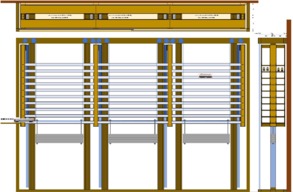March, 12th 2020
This project is still in design stage and probably be for some time since I don't have the space available for stepping into the fase of realizing one of my 'dreams' ...
My goal is to install a model train layout. Wow, nothing special going on … but along that I had the idea of making a storing place, dust free, for the trains while I'm not using them on the layout. This is not so common and what most of the people do is putting this trains back into the boxes, or worse, in a common box all together. That's shame because they are worth looking at and once in a box they risk being forgotten for a long time ...
To solve this problem I saw a good solution on the internet, but the company (Germany) that was making this solution does not exist any more and another one in the UK does not make solutions for the model train scale I'm using (HO).
The only solution was to make ik myself. And I like that a lot because of the challenge.
The starting idea was to make a kind of storage with a lift function. This storage has to be dust free, at least 3 meters long and capable of holding at least 10 to 20 complete trains.
Believe me, that's a lot of requirements for a private train layout … anyway, I want to be ready for the future ;-).
I started designing some time ago until I realized that I had to cope with a number of mysterious and unknown factors: weight and mass, force, torque, CNC, stepper motor, lead screw, ball screw, etc... all new and unfamiliar stuff. I have to admit that it is still at some points mysterious and I hope that with this description of my project I can get some good advise of you, guys!
Another element in this build is costs … still, one cost I will clearly make is the one for the motors and electronics. I don't want to be stuck at the end of this build with a machine that doesn't work.
Things that I can do however (I discovered on the way) is trying to make the construction as cheap as possible without compromising the sturdiness of it. So, I decided NOT to build the machine in aluminium profiles. I examined the cost AND the weight of that kind of build and it is AND costly AND heavy compared to a build with plywood. I surprised me, but for this kind of machine aluminium profiles are really expensive.
So, I decided to develop a plywood construction as well for the supporting structure as for the lift cage itself.
I'm almost done with that … but still some questions are still turning in my head:
- will the stepper motors that I want to use be strong enough to handle the weight?
- do I need some kind of braking system to hold the weight up when standing still?
- do I need end switches? If yes, how do I implement them?
- how do I prevent accidental faling down of the lift? Or is that impossible?
In order to reduce the weight that the stepper motors have to handle, I implemented counter weights that must balance the lift and partially the weight of the trains. I think that is a goof idea since the weight of the lift on its own is around 80kg. The maximum weight of the trains will be around 170kg for 40 trains - yes, I over dimensioned the design to 40 trains ...
The counterweight will then be 80 + 170/2 = 165kg. The remaining weight is then maximum -85kg and +85kg. As far as my limited knowledge of stepper motors reaches, I estimated that 4 high torque nema23 motors in a C-Beam should be able to handle this. PLEASE! Correct me if I'm wrong. The design enables me to install a maximum of 8 C-beams, if necessary.
That's it … for the moment. I plan to add some more details on the design if that is required. The Excel-file shows you 3 views on the build, the front view where you can see the 8 C-Beams (dark en light gray stripes), 1 vertical and one horizontal cut. The "ENTRY/EXIT" sign is where trains can run on and off the lift. The stepper motors are certainly precise enough to stop at the wright levels.
All measurements are in mm.
Model train lift - scale HO
Build in 'OTHER BUILDS/PROJECTS' published by Ivan Burvenich, Mar 12, 2020.
This build is about a model train lift in a secure and dust free storage. It is a roll on/roll off concept for a model train layout.
-
-
-
- Build Progress:
-
- Build in Progress...
Attached Files:
Emrin, David the swarfer and MaryD like this. -
-
Build Author Ivan Burvenich, Find all builds by Ivan Burvenich
-
- Loading...
-
Build Details
- Build License:
-
- CC - Attribution NonCommercial - No Derivs - CC BY NC ND

